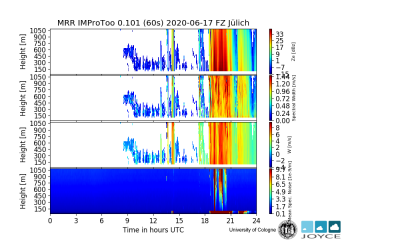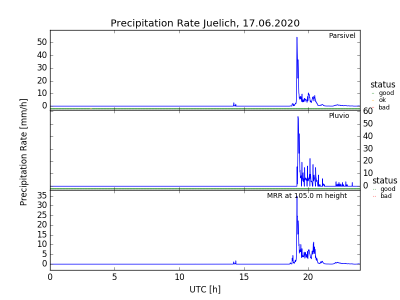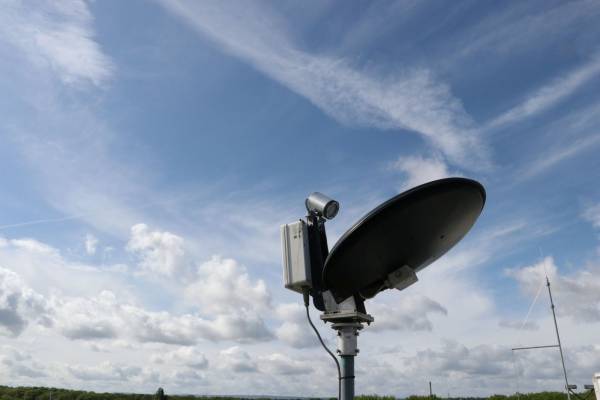Table of Contents
Micro Rain Radar
Principle
The Micro Rain Radar (MRR) is a vertical pointing FM-CW (frequency modulated –continuous wave) Doppler radar operating at 24.1 GHz (K-band, 12.4 mm wavelength). The emitted radar signal (only 50 mW transmitting power) is backscattered by falling hydrometeors (rain, graupel, snow). From the Doppler spectra the radar reflectivity factor (Ze) and the terminal fall velocity distribution can be derived.
In case of rain the Doppler spectra can be used to derive vertical profiles of microphysical rain properties like drop size distribution and rain rate.
The MRR system was also studied for its potential to observe snowfall (Kneifel et al., 2011). Also, an improved MRR algorithm IMProToo most suitable for snowfall observations has been developed at IGMK (Maahn and Kollias, 2012). It is freely available on Github.
Measurement modes
- Vertically pointing observations with integration times from 10 to 3600 seconds.
- The range resolution can be varied from 10 to 200 m which determines together with the 30 range gates the system's maximum height range of 300 to 6000 m.
JOYCE-CF Standard Operation Procedures
- Temporal resolution 10 seconds
- Vertical resolution 35 meters (max. range = 1085 m)
Calibrations and data quality assurance procedures
- ImProToo features a noise removal based on recognition of the most significant peak and a dynamic dealiasing routine which allows observations even if the Nyquist velocity range is exceeded.
Data availability
Data are available on request, please fill the data request sheet and send it to info@joyce.cloud.
| Dataset | Temporal resolution | File size | Filename | Remarks |
|---|---|---|---|---|
| Raw data (ASCII) | 10 seconds | 1 file per day (~15 MB) | YYYYMMDD_jue_mrr_raw_txt.gz | METEK format (zipped) |
| IMProToo (NetCDF) | 1 minute | 1 file per day (20-30 MB) | YYYYMMDD_jue_mrr_improtoo_0-101.nc.gz | IMProToo product (zipped) |
Both available datasets include Doppler spectra, drop spectra, radar reflectivity, rain rate, and fall velocity.
Link to current observations
Data quicklooks can be found in the JOYCE quicklook browser.
Measurement examples


Example time series of MRR observations (left: IMProToo radar reflectivity, spectral width, rain rate and mean spectral noise / right: rain rates from MRR (bottom), compared to Parsivel and Pluvio)
MRR History
Technical Specifications
| Parameter | Specification |
|---|---|
| Frequency | 24.1 GHz |
| Wavel | 12.4 mm |
| Radar Type | FM-CW |
| Transmit Power | 50 mW |
| Receiver | Single Polarization |
| Power consumption (radar) | 25 W |
| Total power cons. incl heating | 525 W |
| Max. range | 6 km |
| Range Resolution | 10-200 m |
| No. of range gates | 30 |
| Temporal resolution | 10 s |
| Antenna diameter | 0.5 m |
| Beam width (2-way, 6 dB) | 1.5° |
| Manufacturer | Metek |
